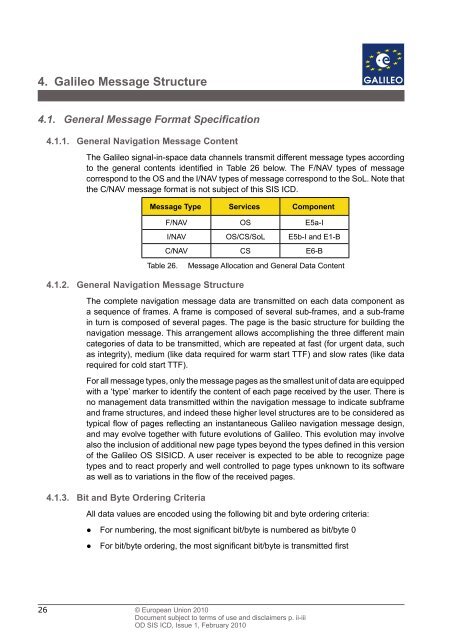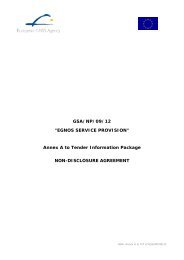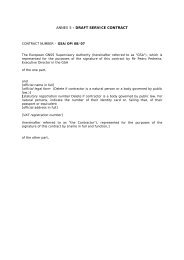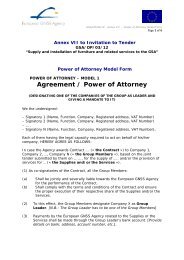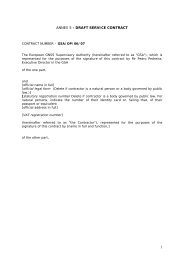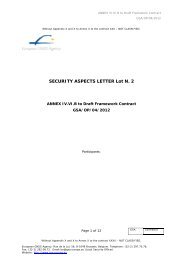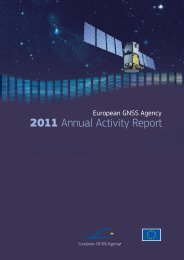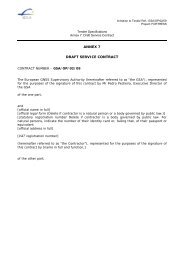Galileo OS SIS ICD.indd - GSA - Europa
Galileo OS SIS ICD.indd - GSA - Europa
Galileo OS SIS ICD.indd - GSA - Europa
You also want an ePaper? Increase the reach of your titles
YUMPU automatically turns print PDFs into web optimized ePapers that Google loves.
4. <strong>Galileo</strong> Message Structure<br />
4.1. General Message Format Specifi cation<br />
4.1.1. General Navigation Message Content<br />
The <strong>Galileo</strong> signal-in-space data channels transmit different message types according<br />
to the general contents identifi ed in Table 26 below. The F/NAV types of message<br />
correspond to the <strong>OS</strong> and the I/NAV types of message correspond to the SoL. Note that<br />
the C/NAV message format is not subject of this <strong>SIS</strong> <strong>ICD</strong>.<br />
Message Type Services Component<br />
F/NAV <strong>OS</strong> E5a-I<br />
I/NAV <strong>OS</strong>/CS/SoL E5b-I and E1-B<br />
C/NAV CS E6-B<br />
4.1.2. General Navigation Message Structure<br />
Table 26. Message Allocation and General Data Content<br />
The complete navigation message data are transmitted on each data component as<br />
a sequence of frames. A frame is composed of several sub-frames, and a sub-frame<br />
in turn is composed of several pages. The page is the basic structure for building the<br />
navigation message. This arrangement allows accomplishing the three different main<br />
categories of data to be transmitted, which are repeated at fast (for urgent data, such<br />
as integrity), medium (like data required for warm start TTF) and slow rates (like data<br />
required for cold start TTF).<br />
For all message types, only the message pages as the smallest unit of data are equipped<br />
with a ‘type’ marker to identify the content of each page received by the user. There is<br />
no management data transmitted within the navigation message to indicate subframe<br />
and frame structures, and indeed these higher level structures are to be considered as<br />
typical fl ow of pages refl ecting an instantaneous <strong>Galileo</strong> navigation message design,<br />
and may evolve together with future evolutions of <strong>Galileo</strong>. This evolution may involve<br />
also the inclusion of additional new page types beyond the types defi ned in this version<br />
of the <strong>Galileo</strong> <strong>OS</strong> <strong>SIS</strong><strong>ICD</strong>. A user receiver is expected to be able to recognize page<br />
types and to react properly and well controlled to page types unknown to its software<br />
as well as to variations in the fl ow of the received pages.<br />
4.1.3. Bit and Byte Ordering Criteria<br />
All data values are encoded using the following bit and byte ordering criteria:<br />
● For numbering, the most signifi cant bit/byte is numbered as bit/byte 0<br />
● For bit/byte ordering, the most signifi cant bit/byte is transmitted fi rst<br />
26 © European Union 2010<br />
Document subject to terms of use and disclaimers p. ii-iii<br />
OD <strong>SIS</strong> <strong>ICD</strong>, Issue 1, February 2010


